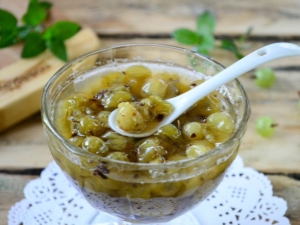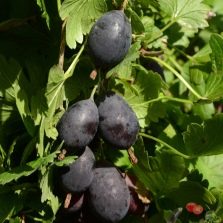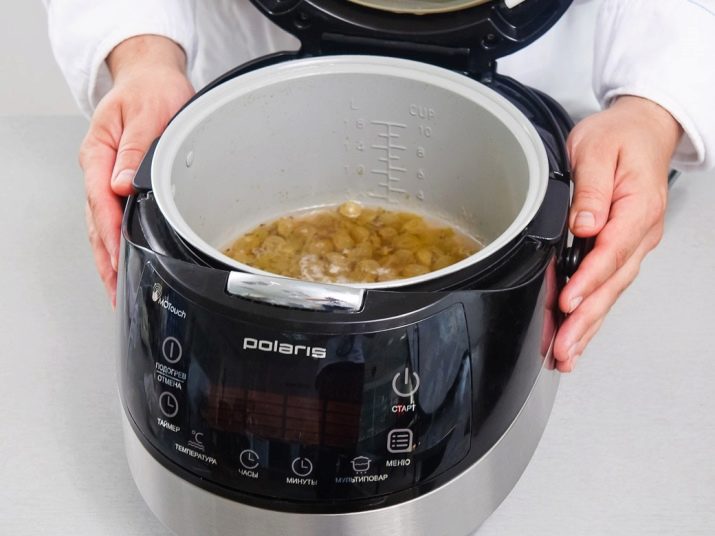How to make jam "five minutes" of gooseberry?

Gooseberry can not be called the most delicious berry, but its specific taste in combination with sugar becomes the ideal basis for fragrant jam.In addition, professionals have long invented the recipe for five-minute jam, the preparation of which takes quite a bit of time, but the resulting result pleases everyone who has tried this dish.
What berries are better to use?
Generally, when preparing the gooseberry jam, you should not worry that the fruit will somehow deteriorate or change shape, since the technology used does not allow them to soften and retains all the useful properties well. Processing does not take much time, so it does not cause any damage, and the vitamin variety that underlies is completely preserved. However, there are still some recommendations on the choice of berries. Of course, you should not choose the gooseberry, which either did not fully ripen, or it was already overcame. In the first case, it will take too long processing, and in the second - the berries will melt and lose their shape. To determine the state of the fruit can be on the skin - it should be moderately elastic and dense. It is preferable to choose the size of a medium, so that in the future it is no problem to use jam as a filling for pies or other dishes.
There are more than fifty varieties of gooseberry and several thousand varieties, the fruits of which differ in color and size. Most often, green and red gooseberries are grown in gardens, so they are used as a rule for making five-minute jams. However, the method of preparation and the recommended proportions are basically the same, which means that an appetizing preparation can be made from black, and from purple and even yellow gooseberries.
Preliminary preparation
The main stage of preparation, of course, is devoted to the processing of the gooseberry itself. The berries are washed thoroughly under a gentle stream of cool water using a colander or a sieve, then dried on a towel, after which the peduncle and the so-called stigma are cut from each. It is more convenient to do this, by the way, not with a knife, but with small scissors, for example, intended for manicure. There is also the option of washing the fruit in a basin, the water in which is updated several times - the main thing is not to squeeze them tightly with your fingers. Washed gooseberry is finally laid out on a sieve.
In addition to the above, there are two more options for processing berries. First, they can be punctured at several points in order to fill with sugar solution, but not lose their integrity. Secondly, the middle part is extracted from the berries along with the seeds.
Be sure to sterilize the containers that will accommodate the jam. Both jars and lids are processed. Covers should be made of metal, but in the case when the workpiece is precisely stored in the refrigerator, it is allowed to use polyethylene.
Banks with lids are treated with either steam or sterilized in a microwave. Five minutes is usually enough for this procedure.
Recipes
A simple recipe for jam “five minutes” requires the use of 1.2 liters of gooseberry berries, 1 kilogram of sugar and 0.2 liters of water. Prepared berries are laid out in a saucepan and covered with half a kilogram of sugar. To reunite the two ingredients it is enough to shake the container several times - so they mix up. The saucepan is removed in the cold for about eight hours to give juice, so it is more convenient to carry out the first stage of cooking in the evening and continue in the morning. After a specified period, the future jam is put on a low fire and begins to warm up before boiling.
At this point, you need to pour out the remaining half a kilo of sugar and gently mix everything with a wooden or silicone spatula. Boil the "five-minute", as you might guess from the name, will succeed in five minutes. All this time, periodically have to clean the foam. If the jam is put in the fridge, it can be immediately poured into prepared jars.In the case when it goes to storage in the underground, it makes sense to first cool the product, then boil for another five minutes, and only then place it in a container. Storing a gooseberry billet at room temperature requires another boiling. Such a treat can be stored for twelve months.
You can cook for the winter “five minutes” and with the use of gelfix - this ingredient will give the dish a pleasant consistency of jam.
The list of ingredients includes a kilo of gooseberry, a kilogram of sugar and one packet of gelix. The washed and dried gooseberries will need to be rotated through a meat grinder. Then 50 grams of granulated sugar are mixed with the gelatin, and the resulting mixture is sprinkled with berry. A container of jam is put on the fire, brought to a boil, stirring constantly, supplemented with sugar residues and brewed for five minutes. It is important to remember to stir the substance all the time and remove the foam. The finished jam is arranged in jars and put in the refrigerator.
A combination of walnut and gooseberry berries is considered quite popular, so it is worth combining them in the “framework” of jam. For the preparation you will need a pound of a little unsatisfied gooseberry, 0.3 kilogram of peeled walnuts, a kilogram of granulated sugar and half a liter of pure water. While the washed gooseberry is dried, the nuts are ground so as to be able to settle inside the berries. Each gooseberry fruit is gently released from the stalk and part of the pulp along with the bones, and instead of the last, nuts are placed there. Sugar and water are cooked until a syrup appears, and then the gooseberry is lowered into the resulting liquid overnight.
In the morning the contents of the pan to be brought to a boil and boil for five minutes. The finished jam is laid out in glass jars with metal lids and immediately removed for storage in the cold.
Owners of such a household helper as a slow cooker can successfully use it to make jam. Berries are prepared in the usual way and, if possible, are kept in a bowl with half of the sugar used for several hours to extract the juice. If this is not possible, then processing takes place immediately. On the control panel of the unit, either the “Quenching” program or the “Multipovar” program and the time of thirty minutes are selected.
No need to close the lid, because otherwise the possibility of removing the foam and mixing will be lost.
The finished jam is cooled, and then brought back to a boil and boiled for five minutes. Then the food cools again, and the boiling procedure is carried out once more. After its completion, the finished billet can already be poured into jars.
By the way, it is worth mentioning that the gooseberry "five-minute" is well combined with other fruits, for example, with lemon and orange. In the first case, 600 grams of berries will have to be supplemented with a half of citrus, ground in a blender or cut into small pieces. Lemon will be immediately added to the sugar syrup along with the gooseberries, and all other cooking steps will be the same.
In the case of an orange, the fruit is also either grilled in a meat grinder or ground in a blender. You can use either a crust with pulp, or the whole orange, but without stones. Gooseberry in the amount of 600 grams will be supplemented with a couple of oranges and 500 grams of granulated sugar. Berries and citrus are ground together and combined with a glass of sugar. Then everything is mixed and cleaned on a low fire. Substance to bring to a boil, stirring constantly, then combine with the remnants of sugar, mix again and bring to a boil again. The food is boiled for about five minutes, and then poured into prepared containers.
Choosing black gooseberry as a base, you can slightly modify the recipe to make a marvelous delicacy that has a delicate flavor and a double supply of vitamins.In addition to a kilogram of fruit, you will need to prepare a kilogram of sugar, half a liter of pure water, one sprig of mint and a few cherry or currant leaves. Washed gooseberries are stabbed with a toothpick to create holes through which sugar syrup is poured into the berries. Then the fruits, together with mint and leaves, are laid out in a separate container. At this time, sugar and water are brought to a boil, and the resulting syrup pours the contents of the pan, which is then left alone for a couple of hours.
After a specified time, the present mass is cleared of mint and leaves, and the jam is put on fire. It will need to bring to a boil and boil for exactly five minutes. The finished dish immediately spreads on the banks and rolls.
Useful recommendations
In the case when the resulting jam seems too liquid, you can add agar-agar, gelatin, pectin or other substances responsible for the formation of jelly and thereby compacting the existing texture. It is necessary to use thickeners, according to the instructions on the package - usually the powder is diluted in water in a separate container, and then, constantly stirring, is introduced into the jam. Professionals also do not recommend in any case to use dishes made of aluminum, and prefer enameled. The fact is that the interaction of food acids and this metal leads to the release of harmful substances that not only spoil the taste of the preform, but also, quite possibly, cause harm to the human body.
Gooseberry jam should be stored at a temperature not exceeding from sixteen to eighteen degrees. As a rule, it is either a basement or a special pantry that is not heated. A few words need to be added about the foam that stands out during cooking. Although most housewives just throw it away, some believe that the by-product can be added to cottage cheese, ice cream or yogurt to give gooseberry flavor to dairy products.
By the way, it is possible to determine whether the jam is ready by dropping a bit of mass onto a plate. If it does not spread, then it is already possible to complete the process.
See the following video for an unusual recipe for gooseberry jam.
































